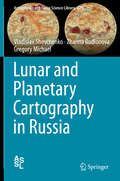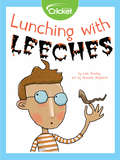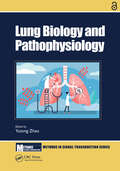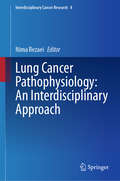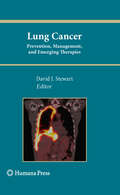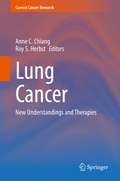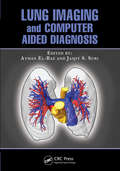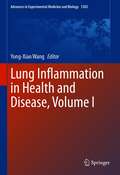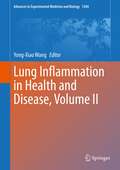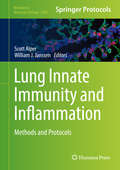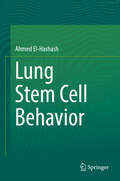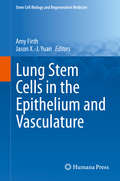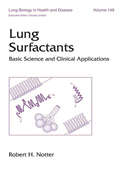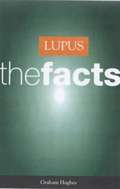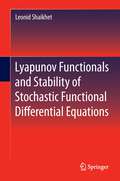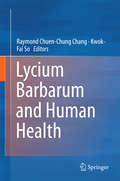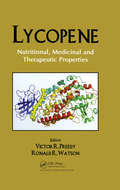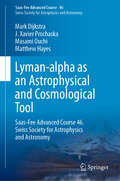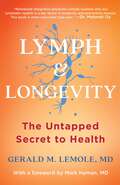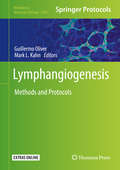- Table View
- List View
Lunar and Planetary Cartography in Russia
by Vladislav Shevchenko Zhanna Rodionova Gregory MichaelThis book is the first to document in depth the history of lunar and planetary cartography in Russia. The first map of the far side of the Moon was made with the participation of Lomonosov Moscow University (Sternberg Astronomical Institute, MSU) in 1960. The developed mapping technologies were then used in preparing the "Complete Map of the Moon" in 1967 as well as other maps and globes. Over the years, various maps of Mars have emerged from the special course "Mapping of extraterrestrial objects" in the MSU Geography Department, including the hypsometric map of Mars at a scale of 1:26,000,000, compiled by J. A. Ilyukhina and published in 2004 in an edition of 5,000 copies. A more detailed version of this map has since been produced with a new hypsometric scale. In addition, maps of the northern and southern hemispheres of Mars have been compiled for the hypsometric globe of Mars. Relief maps of Venus were made in 2008, 2010, and 2011, and hypsometric maps of Phobos and Deimos at a scale of 1:60,000 were published in 2011. History of Lunar and Planetary Cartography in Russia provides detailed information on the compilation of this diverse range of maps and will be of interest to all lunar and planetary cartographers.
Lunching with Leeches
by Lela StanleyMost people wouldn't want to be bitten by a leech. But can they be used for good? This article discusses leeches and their history of helping doctors and scientists.
Lung Biology and Pathophysiology (Methods in Signal Transduction Series)
by Yutong ZhaoThe lungs are the organ for gas exchange between the body and the external environment. Dysfunction of upper airway epithelium and smooth muscle cells leads to pathogenesis of asthma, chronic obstructive pulmonary disease (COPD), cystic fibrosis, and other conditions, resulting in airway inflammation and narrowing. Injury to alveolar epithelium and endothelium causes influx of neutrophil and protein-rich fluid from circulation, resulting in edema and disruption of gas exchange. In addition to lung structural cells, immune cells, including alveolar macrophages and lymphocytes play critical roles in the maintenance of lung function. This book contributes to the understanding homeostasis of lung cells in the physiological and pathological conditions critical to the development of novel therapeutics.Key Features Highlights the role the lungs play as an interface between the body and the environment Describes the underlying mechanism of lung diseases Emphasizes the ways nutrition contributes to lung health as well as the ways pollution adversely affect lung function Includes contributions from leading researchers Chapters 8 and 13 of this book are available for free in PDF format as Open Access from the individual product page at www.routledge.com. It has been made available under a Creative Commons Attribution-Non Commercial-No Derivatives 4.0 license.
Lung Cancer Imaging
by James G. RavenelWhile specialists often guide the care to lung cancer patients, it is often a general radiologist who is left to interpret studies that impact patient care and management. Lung Cancer Imaging provides a comprehensive guide to the diagnosis, staging and overview of the management of lung cancer relevant to practicing radiologists so that they can better understand the decision making issues and provide more directed and useful communication to the treating physicians. It Primary Care physicians will also find this book valuable to understand the relevant issues that they face when one of their patients is being treated for lung cancer.
Lung Cancer Pathophysiology: An Interdisciplinary Approach (Interdisciplinary Cancer Research #8)
by Nima RezaeiLung cancer is one of the most common cancers and the leading cause of deaths worldwide. The eighth volume of the “Interdisciplinary Cancer Research” series, entitled “Lung Cancer Pathophysiology: An Interdisciplinary Approach” publishes comprehensive reviews on the mechanisms of lung cancer. Fundamental elements of a lung cancer multidisciplinary team are discussed. The epithelial to mesenchymal transition in lung cancer, and the roles of tumor immune microenvironment, NK cells, RNA, micro-RNA, and long-non coding RNA in lung cancer are explained. A comprehensive genomic profiling in lung cancer in the era of immunotherapy approaches is also provided in this volume. This interdisciplinary series is of special value to researchers working on oncology. This is the main concept of Cancer Immunology Project (CIP), which is a part of Universal Scientific Education and Research Network (USERN). This interdisciplinary book will be of special value to researchers, oncologists, and oncosurgeons who wish to extend their knowledge on lung cancer.
Lung Cancer:
by David J. StewartThis comprehensive resource provides authoritative knowledge of the most up-to-date prevention and treatment strategies for thoracic malignancies. Established and investigational therapies are placed in the context of tumor biology for a full understanding of the pharmacogenetics, etiology, and changing epidemiology of lung cancer. Expert clinicians detail the function of predictive and prognostic factors in the utilization of chemo-radiotherapy, adjuvant and neoadjuvant treatment, and targeted agents. The promises and potential pitfalls of investigational strategies are evaluated with exceptional insight and clarity, with unique attention paid to the mechanisms of drug resistance and targets for lung cancer treatment and prevention. Lung Cancer: Prevention, Management, and Emerging Therapies engages the entire spectrum of therapeutic modalities with focus on systemic approaches. Disease coverage includes newly diagnosed and recurrent non-small cell lung cancer, small cell carcinoma, and mesothelioma. Critical examination of the impact, methodology, and design of clinical trials is presented along with new paradigms for personalized approaches and individual risk assessment.
Lung Cancer: New Understandings and Therapies (Current Cancer Research)
by Anne C. Chiang Roy S. HerbstLung cancer has seen a paradigm shift in disease treatment over the past few years, with major changes in the therapeutic drugs now available as well as in the overall management approach. For targeted and immunotherapeutic approaches, understanding the biology of acquired resistance is a key strategy that has yielded productive advances in the subsequent treatment. Future advances also include incorporating biomarker data obtained from solid and liquid biopsies, as well as combination of immunotherapy with radiotherapy and in special populations such patients with CNS involvement.
Lung Imaging and CADx
by Jasjit Suri Ayman El-BazDeveloping an effective computer-aided diagnosis (CAD) system for lung cancer is of great clinical importance and can significantly increase the patient's chance for survival. For this reason, CAD systems for lung cancer have been investigated in a large number of research studies. A typical CAD system for lung cancer diagnosis is composed of four main processing steps: segmentation of the lung fields, detection of nodules inside the lung fields, segmentation of the detected nodules, and diagnosis of the nodules as benign or malignant. This book overviews the current state-of-the-art techniques that have been developed to implement each of these CAD processing steps. Overviews the latest state-of-the-art diagnostic CAD systems for lung cancer imaging and diagnosis Offers detailed coverage of 3D and 4D image segmentation Illustrates unique fully automated detection systems coupled with 4D Computed Tomography (CT) Written by authors who are world-class researchers in the biomedical imaging sciences Includes extensive references at the end of each chapter to enhance further study Ayman El-Baz is a professor, university scholar, and chair of the Bioengineering Department at the University of Louisville, Louisville, Kentucky. He earned his bachelor’s and master’s degrees in electrical engineering in 1997 and 2001, respectively. He earned his doctoral degree in electrical engineering from the University of Louisville in 2006. In 2009, he was named a Coulter Fellow for his contributions to the field of biomedical translational research. He has 17 years of hands-on experience in the fields of bio-imaging modeling and noninvasive computer-assisted diagnosis systems. He has authored or coauthored more than 500 technical articles (132 journals, 23 books, 57 book chapters, 211 refereed-conference papers, 137 abstracts, and 27 U.S. patents and disclosures). Jasjit S. Suri is an innovator, scientist, a visionary, an industrialist, and an internationally known world leader in biomedical engineering. He has spent over 25 years in the field of biomedical engineering/devices and its management. He received his doctorate from the University of Washington, Seattle, and his business management sciences degree from Weatherhead School of Management, Case Western Reserve University, Cleveland, Ohio. He was awarded the President’s Gold Medal in 1980 and named a Fellow of the American Institute of Medical and Biological Engineering for his outstanding contributions in 2004. In 2018, he was awarded the Marquis Life Time Achievement Award for his outstanding contributions and dedication to medical imaging and its management.
Lung Imaging and Computer Aided Diagnosis
by Jasjit S. Suri Ayman El-BazLung cancer remains the leading cause of cancer-related deaths worldwide. Early diagnosis can improve the effectiveness of treatment and increase a patient's chances of survival. Thus, there is an urgent need for new technology to diagnose small, malignant lung nodules early as well as large nodules located away from large diameter airways because
Lung Inflammation in Health and Disease, Volume I (Advances in Experimental Medicine and Biology #1303)
by Yong-Xiao WangRespiratory diseases are leading causes of death and disability globally, with about 65 million people suffering from COPD, and 334 million from asthma, the most common chronic disease. Each year, tens of millions of people develop and can die from from respiratory infections such as pneumonia and TB. Systemic inflammation may induce and exacerbate local inflammatory diseases in the lungs, and local inflammation can in turn cause systemic inflammation. There is increasing evidence of the coexistence of systemic and local inflammation in patients suffering from asthma, COPD, and other lung diseases, and the co-morbidity of two or more local inflammatory diseases often occurs. For example, rheumatoid arthritis frequently occurs together with, and promotes the development of, pulmonary hypertension. This co-morbidity significantly impacts quality of life, and can result in death for those affected.Current treatment options for lung disease are neither effective, nor condition-specific; there is a desperate need for novel therapeutics in the field. Additionally, the molecular and physiological significance of most major lung diseases is not well understood, which further impedes development of new treatments, especially in the case of coexistent lung diseases with other inflammatory diseases. Great progress has been made in recent years in many areas of the field, particularly in understanding the molecular geneses, regulatory mechanisms, signalling pathways, and cellular processes within lung disease, as well as basic and clinical technology, drug discovery, diagnoses, treatment options, and predictive prognoses. This is the first text to aggregate these developments. In two comprehensive volumes, experts from all over the world present state-of-the-art advances in the study of lung inflammation in health and disease. Contributing authors cover well-known as well as emerging topics in basic, translational, and clinical research, with the aim of providing researchers, clinicians, professionals, and students with new perspectives and concepts. The editors hope these books will also help to direct future research in lung disease and other inflammatory diseases, and result in the development of novel therapeutics.
Lung Inflammation in Health and Disease, Volume II (Advances in Experimental Medicine and Biology #1304)
by Yong-Xiao WangLung diseases are leading causes of death and disability globally, with about 65 million people suffering from COPD, and 334 million from asthma. Each year, tens of millions of people develop and can die from lung infections such as pneumonia and TB. Systemic inflammation may induce and exacerbate local inflammatory diseases in the lungs, and local inflammation can in turn cause systemic inflammation. There is increasing evidence of the coexistence of systemic and local inflammation in patients suffering from asthma, COPD, and other lung diseases, and the co-morbidity of two or more local inflammatory diseases often occurs. For example, rheumatoid arthritis frequently occurs together with, and promotes the development of, pulmonary hypertension. This co-morbidity significantly impacts quality of life, and can result in death for some patients. Current treatment options for lung disease are neither always effective, nor condition-specific; there is a desperate need for novel therapeutics in the field. Additionally, the molecular and physiological significance of most major lung diseases is not well understood, which further impedes development of new treatments, especially in the case of coexistent lung diseases with other inflammatory diseases. Great progress has been made in recent years in many areas of the field, particularly in understanding the molecular geneses, regulatory mechanisms, signalling pathways, and cellular processes within lung disease, as well as basic and clinical technology, drug discovery, diagnoses, treatment options, and predictive prognoses. This is the first text to aggregate these developments. In two comprehensive volumes, experts from all over the world present state-of-the-art advances in the study of lung inflammation in health and disease. Contributing authors cover well-known as well as emerging topics in basic, translational, and clinical research, with the aim of providing researchers, clinicians, professionals, and students with new perspectives and concepts. The editors hope these books will also help to direct future research in lung disease and other inflammatory diseases, and result in the development of novel therapeutics.
Lung Innate Immunity and Inflammation: Methods and Protocols (Methods in Molecular Biology #1809)
by Scott Alper William J. JanssenThis detailed book explores methods to isolate, characterize, and investigate key lung innate immune cells. Beginning with an overview, the volume then continues with methods for creating in vitro and in vivo model systems to study inflammatory lung diseases. Written in the highly successful Methods in Molecular Biology series format, chapters include introductions to their respective topics, lists of the necessary materials and reagents, step-by-step, readily reproducible laboratory protocols, and tips on troubleshooting and avoiding known pitfalls.Authoritative and cutting-edge, Lung Innate Immunity and Inflammation: Methods and Protocols aims to be a guidebook and will be of value and interest to researchers investigating innate immunity and inflammation in the lung as well as other organs and tissues.
Lung Stem Cell Behavior
by Ahmed El-HashashThis book reviews stem cell behavior in the lung as it relates to regenerative medicine and stem cell therapeutics. Topics ranging from basic developmental mechanisms of various types of lung stem cells through the identification and properties of stem cell behavior and their potential applications in lung repair and regeneration, are discussed by an expert in the field. These discoveries are placed within the structural context of tissue and developmental biology in sections dealing with recent advances in understanding of developmental lung stem cell biology and behavior and their potential applications. Lung Stem Cell Behavior is essential reading for researchers in stem cell biology and regenerative medicine, patient advocates, undergraduate students, graduate students, and clinicians interested in cellular therapy and tissue engineering therapies.
Lung Stem Cells in the Epithelium and Vasculature
by Amy Firth Jason X.-J. YuanThis book covers the identification and role of endogenous lung stem cells in health and disease, particularly the most recent advances. In addition, it discusses the rapidly growing field of stem cells and cell therapy as it relates to lung biology and disease as well as ex vivo lung bioengineering. Such approaches may provide novel therapeutic approaches for lung diseases. Human pluripotent stem cell differentiation to model the pulmonary epithelium and vasculature is also discussed. World-recognized scientists who specialize in studying both the lung epithelium and pulmonary vasculature contribute the chapters. Topics covered include: stem cell niches in the lung, the role of progenitor cells in fibrosis and asthma, iPSC in modeling lung disease, vascular repair by endothelial progenitor cells and circulating fibrocytes in pulmonary vascular remodeling. This volume of the Stem Cell Biology and Regenerative Medicine series is essential reading for researchers and clinicians interested in stem cells, lung biology and regenerative medicine. It is also an invaluable resource for advanced students studying cell biology, regenerative medicine and lung physiology.
Lung Surfactants: Basic Science and Clinical Applications (Lung Biology in Health and Disease)
by Knud Erik SkoubyIntegrating basic and clinical research on the biophysical and physiological functions of pulmonary surfactants, this practical reference presents thorough, cutting-edge coverage on surfactant-related lung disease. Manage neonatal respiratory distress syndrome (RDS), acute respiratory distress syndrome (ARDS), and acute lung injury more effecti
Lupus The Facts
by Graham HughesThis easy-to-read book explains Lupus. How does Lupus affect people? What can be done if someone develops lupus?
Lust und Liebe - alles nur Chemie? (Erlebnis Wissenschaft)
by Rolf Froböse Gabriele FroböseHinter dem Titel des Bandes verbirgt sich mehr als bloß die Analyse von Aphrodisiaka oder Potenzmitteln. Großhirnrinde, Hypophyse oder körpereigene Opiate: Sie alle sind beteiligt, wenn Verliebte sich küssen oder ein junger Mann seinem ersten Rendezvous entgegenfiebert. Dieses unterhaltsame Buch wirft einen Blick hinter die molekularen Kulissen des aufregendsten aller Gefühle. Die Liebe schlägt nicht nur Verliebte in ihren Bann. Dass auch Chemiker manch faszinierende Erkenntnis zu diesem Phänomen vermitteln können, belegt dieses Buch eindrucksvoll. Ihren wissenschaftlichen Streifzug durch Amors Reich beginnt das Autorenduo (das übrigens auch ein Autorenpaar ist) mit einer Geschichte: Zwei Verliebte treffen sich wieder, nachdem sie sich eine Weile nicht gesehen haben. Was geschieht in ihren Köpfen? Wie lassen sich ihre Verhaltensweisen und Reaktionen chemisch beschreiben? Im Anschluss widmen sich die beiden Wissenschaftsjournalisten ausführlich der "Mentalität" der Liebe: Sie gehen der Frage nach, wie sie im menschlichen Gehirn repräsentiert wird. Auch den "Dialog der Düfte" entschlüsseln sie und fragen nach den physiologischen Hintergründen von Zärtlichkeit und Treue. Sie erklären, wie Moleküle unsere Emotionen steuern, und belegen, dass sich Verliebte wirklich gut "riechen" können. Nicht nur Chemiker dürfte interessieren, was das Buch über die "Wirkstoffe der Liebe" zu berichten weiß. Mal ergründet es die Funktionsweise körpereigener Opiate, dann wenden sich die Autoren den Aphrodisiaka zu oder referieren den Stand der Dinge in Sachen Potenzmittel. Die Fortsetzung der kleinen Liebesgeschichte vom Anfang sowie ein Sach- und Personenregister beschließen den Band.
Lyapunov Functionals and Stability of Stochastic Functional Differential Equations
by Leonid ShaikhetStability conditions for functional differential equations can be obtained using Lyapunov functionals. Lyapunov Functionals and Stability of Stochastic Functional Differential Equations describes the general method of construction of Lyapunov functionals to investigate the stability of differential equations with delays. This work continues and complements the author's previous book Lyapunov Functionals and Stability of Stochastic Difference Equations, where this method is described for difference equations with discrete and continuous time. The text begins with both a description and a delineation of the peculiarities of deterministic and stochastic functional differential equations. There follows basic definitions for stability theory of stochastic hereditary systems, and the formal procedure of Lyapunov functionals construction is presented. Stability investigation is conducted for stochastic linear and nonlinear differential equations with constant and distributed delays. The proposed method is used for stability investigation of different mathematical models such as: * inverted controlled pendulum; * Nicholson's blowflies equation; * predator-prey relationships; * epidemic development; and * mathematical models that describe human behaviours related to addictions and obesity. Lyapunov Functionals and Stability of Stochastic Functional Differential Equations is primarily addressed to experts in stability theory but will also be of interest to professionals and students in pure and computational mathematics, physics, engineering, medicine, and biology.
Lyapunov Stability of Transformation Semigroups (Latin American Mathematics Series)
by Victor H. Rocha Josiney A. SouzaThis book presents recent research results on Lyapunov stability and attraction for semigroup actions in a pedagogical format, providing the reader with numerous modern ideas and mathematical formulations for dynamical concepts in the transformation group theory. In recent decades, many fundamental concepts of dynamical systems have been extended to the general framework of transformation semigroups. Limit sets, attractors, isolated invariant sets, prolongational limit sets, and stable sets now have semigroup theoretical analogues. This monograph consolidates recent advancements in this field in a way that makes it accessible to graduate students. An effort was made to relate the presented results to important recurrence notions, for contextual clarity. A rudimentary understanding of group theory and topology, including the concepts of semigroup action, orbit, fiber bundle, compactness, and connectedness, is a prerequisite for reading this text. As a valuable resource for research projects and academic dissertations on topological dynamics, geometry, and mathematical analysis, this work can potentially open new avenues for further research.
Lycium Barbarum and Human Health
by Raymond Chuen-Chung Chang Kwok-Fai SoThis book seeks to unravel the mysteries of wolfberry, and systematically introduces its mechanisms in preventing aging-associated diseases, such as cardiovascular diseases, inflammation, liver and neurodegenerative diseases. Wolfberry, the dried fruit of Lycium barbarum, is an anti-aging herbal medicine. There have been numerous reports investigating the underlying mechanisms of its anti-aging effects and its role in preventing pathological changes in many aging-associated diseases. Its holistic effects on the body can attenuate liver toxicity and combat the spread of cancer; it also prevents degeneration in the central nervous system, and can even positively affect the skin. As such, wolfberry has become a very popular food supplement around the world. This book will serve as an excellent reference source for researchers and graduate students studying herbal medicine and aging-associated diseases, while also providing insights for the pharmaceutical industry with regard to developing potential drugs for these diseases.
Lycopene: Nutritional, Medicinal and Therapeutic Properties
by Victor R. Preedy Ronald R. WatsonTomatoes have become a dietary staple for humans in many parts of the world. The characteristic deep red color of the ripe tomato fruit and related products is mainly due to lycopene. Lycopene is the predominant carotenoid in tomatoes, followed by a-carotene, b-carotene, g-carotene, and phytoene, as well as by several other minor carotenoids. Tomat
Lyman-alpha as an Astrophysical and Cosmological Tool: Saas-Fee Advanced Course 46. Swiss Society for Astrophysics and Astronomy (Saas-Fee Advanced Course #46)
by Matthew Hayes Mark Dijkstra J. Xavier Prochaska Masami OuchiThe hydrogen Lyman-alpha line is of utmost importance to many fields of astrophysics. This UV line being conveniently redshifted with distance to the visible and even near infrared wavelength ranges, it is observable from the ground, and provides the main observational window on the formation and evolution of high redshift galaxies. Absorbing systems that would otherwise go unnoticed are revealed through the Lyman-alpha forest, Lyman-limit, and damped Lyman-alpha systems, tracing the distribution of baryonic matter on large scales, and its chemical enrichment.We are living an exciting epoch with the advent of new instruments and facilities, on board of satellites and on the ground. Wide field and very sensitive integral field spectrographs are becoming available on the ground, such as MUSE at the ESO VLT. The giant E-ELT and TMT telescopes will foster a quantum leap in sensitivity and both spatial and spectroscopic resolution, to the point of being able, perhaps, to measure directly the acceleration of the Hubble flow. In space, the JWST will open new possibilities to study the Lyman-alpha emission of primordial galaxies in the near infrared. As long as the Hubble Space Telescope will remain available, the UV-restframe properties of nearby galaxies will be accessible to our knowledge. Therefore, this Saas-Fee course appears very timely and should meet the interest of many young researchers.
Lyme Disease: Why It’s Spreading, How It Makes You Sick, and What to Do about It (A Johns Hopkins Press Health Book)
by Alan G. BarbourA world-renowned Lyme disease expert explains everything you need to know if you live, work, or play in areas with the ticks that carry disease.Once restricted to small forested areas in the northeast and north-central United States, Lyme disease is now a common infection in North America and Europe. The Centers for Disease Control and Prevention estimate that more than 300,000 new cases occur each year in the United States. Misunderstandings over symptoms and treatment increase the public's concerns about the disease—which, if not properly treated, can become chronic and debilitating. An expert on tick-borne diseases, Alan G. Barbour explains the course of illness that results from infection, diagnosis and treatment options, and steps that can be taken to avoid a tick bite in the first place. The ticks that transmit Lyme disease may also transmit other disease-causing pathogens, and these other infections are considered as well. Drawing on real case histories of individuals with Lyme disease—or illnesses that may be mistaken for Lyme disease—Barbour explains: The biology of the spirochete, Borrelia burgdorferi, that causes Lyme disease The role of animals such as mice that carry the infection The life cycle of the ticks that transmit the infection The importance of deer in perpetuating the cycle The basics of diagnostic laboratory tests and how test results are interpreted How antibiotics are used in treating Lyme diseaseInfected ticks are abundant in the woods, in walking trails, and in the shrubs and tall grass where suburban lawns meet wooded areas. Barbour stresses preventing disease through community-wide ecology projects and individual and household protection. While it may be difficult to escape infection, understanding the danger, the symptoms, and the treatment goes a long way toward preventing long-term health consequences. Featuring a list of reliable web sites and a glossary of terms, Lyme Disease is an invaluable resource for everyone who is at risk of the disease or is involved in preventing and treating it.
Lymph & Longevity: The Untapped Secret to Health
by M.D. Gerald LemoleLearn how you can boost your immune system and help prevent virtually every major medical condition—including cancer, heart disease, neurological disorders, GI issues, and obesity—by keeping your lymph system healthy, as explained by renowned cardiologist Gerald Lemole.The lymphatic system serves as our body&’s maintenance department and has a direct effect on our cardiovascular, neurological, and immune systems. It has also been one of the most misunderstood systems. Until now. At last, renowned cardiothoracic surgeon and pioneer in the study of lymph Gerald Lemole explains in straightforward language why the lymphatic system is the key factor in longevity and disease prevention, and how improving lymphatic flow can help our bodies eliminate the toxins and waste products that contribute to injury, inflammation, and disease. In ten short chapters he demystifies the lymphatic system, describes how powerful it is, and shows how to maintain a healthy lymph system to combat specific diseases and health problems—from heart disease to cognitive function to weight management. Featuring sidebars with charts and graphs that illustrate basic principles, Lymph & Longevity also includes flow-friendly menus, recipes, and information on supplements, as well as basic yoga and meditation guides. Illuminating, informative, and practical this essential guide is more timely now than ever as we continue to work to protect ourselves and our communities against Covid-19 and other viruses.
Lymphangiogenesis: Methods and Protocols (Methods in Molecular Biology #1846)
by Guillermo Oliver Mark L. KahnThis volume discusses the latest tools, techniques, and animal models designed to study the processes of lymphatic vascular formation in vivo and in vitro and its functions in health and disease. The chapters in the book cover topics such as genetics lineage tracing of lymphatic endothelial cells in mice; characterization of zebrafish facial lymphatics; imaging lymphatics in mouse lungs; effects of fluid shear stress of lymphatic endothelial cells; and single cell mRNA sequencing of the mouse brain vasculature. Written in the highly successful Methods in Molecular Biology series format, chapters include introductions to their respective topics, lists of the necessary materials and reagents, step-by-step, readily reproducible laboratory protocols, and tips on troubleshooting and avoiding known pitfalls.Cutting-edge and comprehensive, Lymphangiogenesis: Methods and Protocols is a valuable resource to aid researchers with applying new approaches to answer their questions in this developing field.
